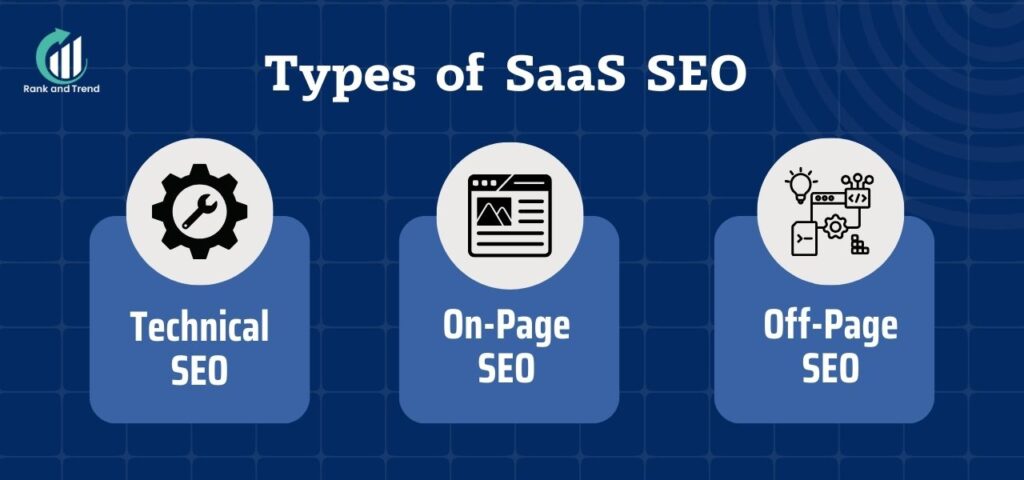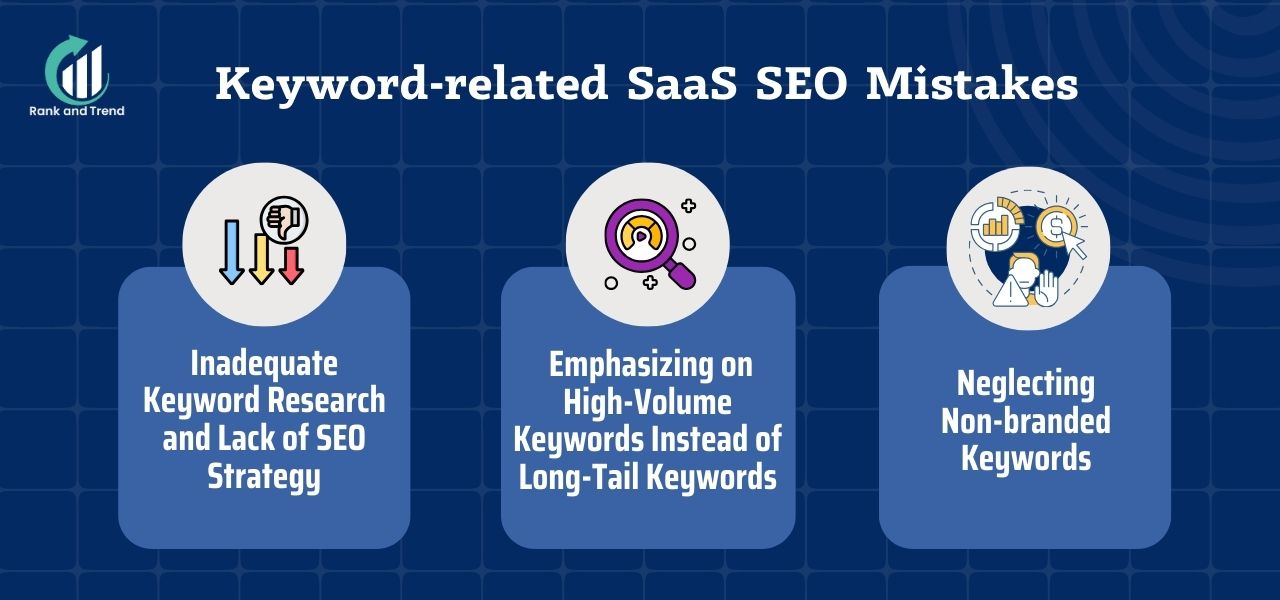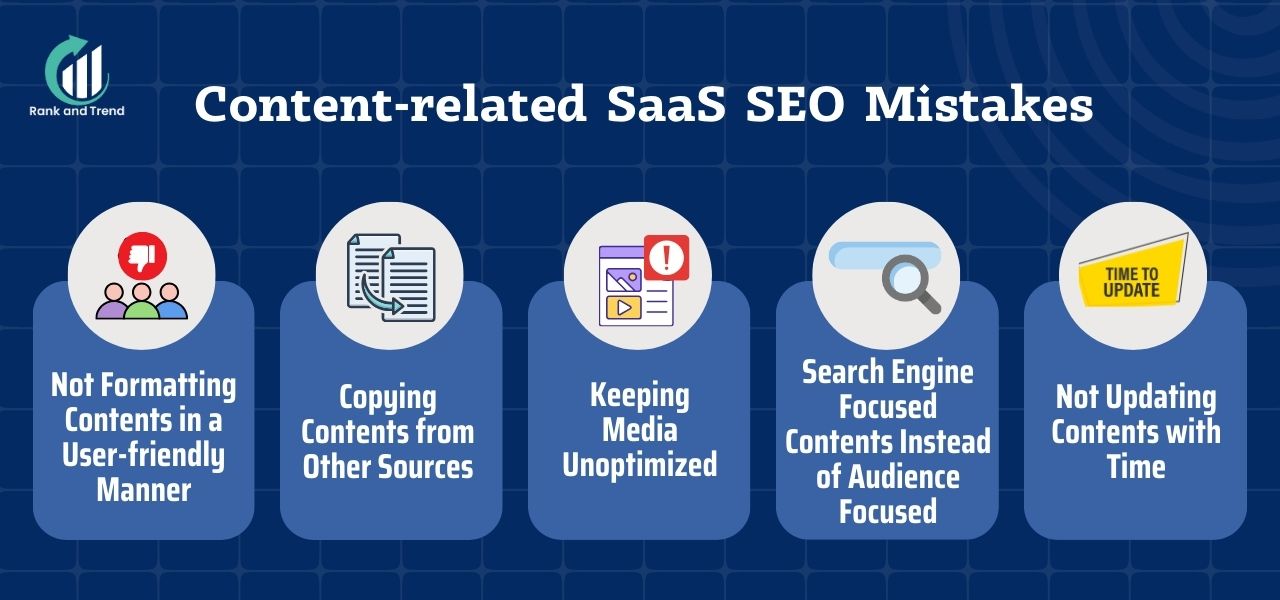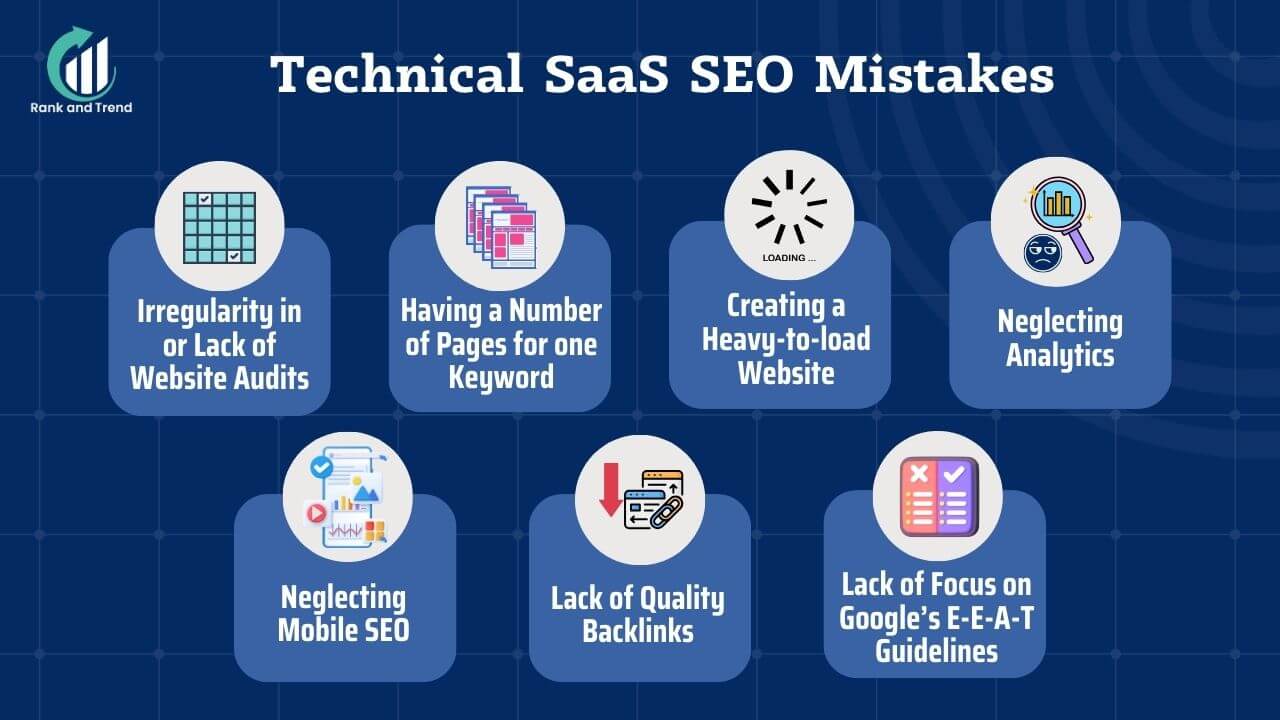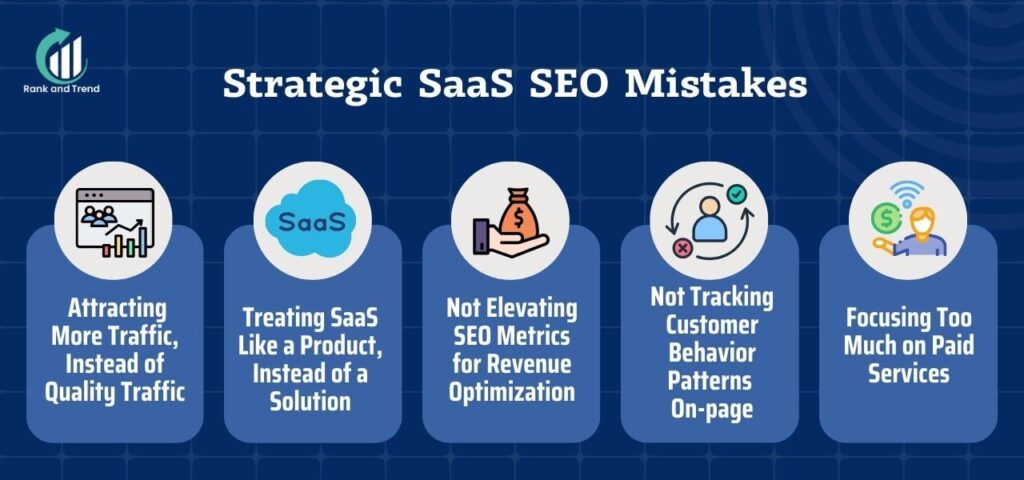20 Common SaaS SEO Mistakes and How to Avoid Them

Table of Contents
Search engine optimization (SEO) is crucial for Software as a Service (SaaS) companies to reach their target audience and drive growth. However, many SaaS companies make common SEO mistakes that can hinder their online visibility and organic traffic even though they’ve spent significant resources after SEO and doing almost everything else correctly.
SaaS SEO mistakes can be technical or strategic in nature. They can be as simple as keywords selection mistakes or as technical as indexing or data markup. Upon reading this whole article, you should be clearly able to understand SaaS SEO mistakes that are common and how to avoid them.
Why is SEO Crucial for SaaS Companies?
Before we move to SaaS SEO mistakes, it’s crucial to understand why of all things, specifically SaaS SEO is important and how that differs from other SEOs. According to Industry Research, SaaS market size in 2022 was estimated to be USD 96760 million, with a compound annual growth rate (CAGR) of 15.9% and expected to reach USD 234900 million within 2028.
This aligns with BetterCloud’s finding that SaaS is the 2nd fastest growing market, second to only tech related hardwire. Companies estimate that 70% of the business apps they use today are SaaS-based which they expect will reach 85% in 2025.
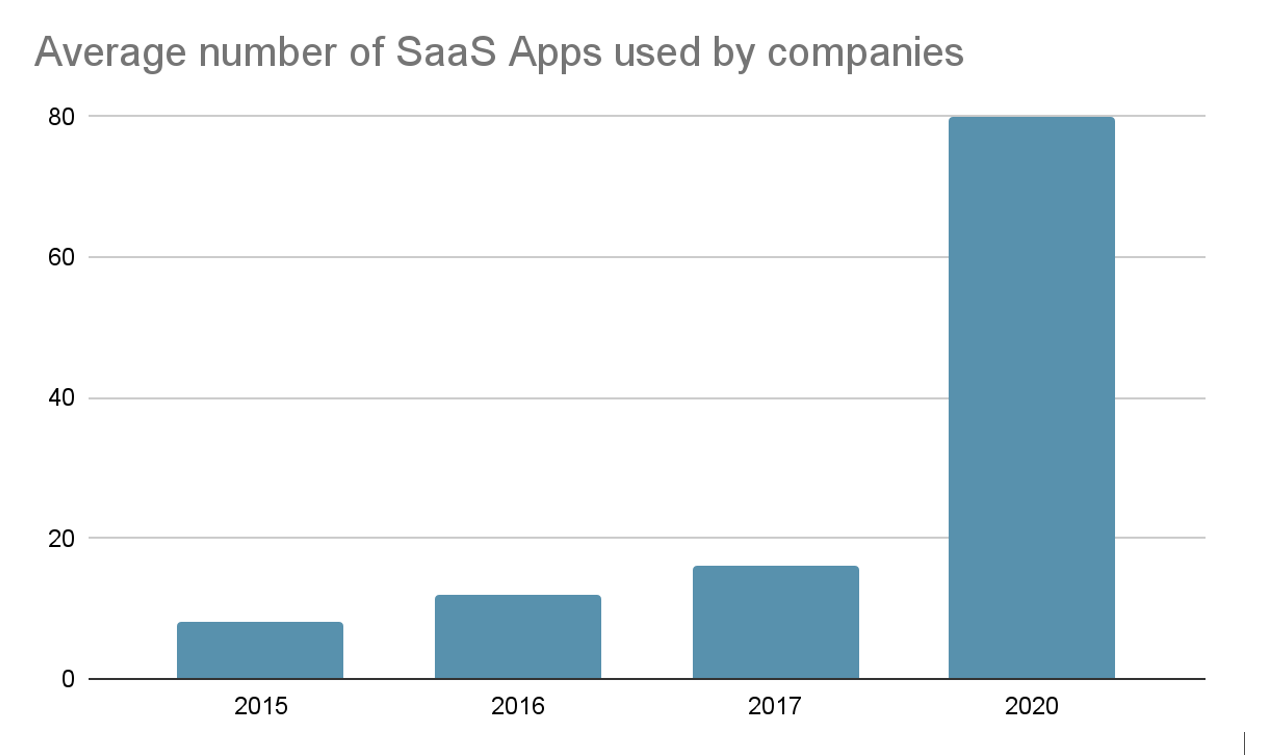
The number of SaaS apps used by companies have increased from 8 in 2015 to 80 in 2020, a 1000% increase. However, the market for cloud services is already dominated by giants such as IBM, Oracle Corporation, Microsoft, Fujitsu, Google, Salesforce etc.
On the other hand, Customer Relationship Management (CRM) software, Enterprise Resource Planning (ERP) software, Human Resource Management (HRM) software and Supply Chain Management (SCM) software and other Software as a Service remains significantly competitive. According to BetterCloud, among the average 80 SaaS apps used, 21 SaaS apps are custom apps, making scope for your company to grab a significant market share in one of the fastest growing industries.
And that is where SEO comes in. Firstly, it provides you visibility on the internet, which creates brand value and attracts customers. Secondly, the internet is the best source for SaaS companies to attract customers since most of their products are tech related solutions and they don’t have a physical showroom for their customers to visit.
Types of SaaS SEO and Their Differences
There are THREE types of SEOs that can help your website improve its visibility – Technical SEO that deals with the website’s technical infrastructure and code, On-page SEO that deals with individual pages and their visibility for a specific keyword and Off-page SEO that deals with redirecting traffic from other places in the internet and local SEO. Following is a brief description of these three.
Technical SEO
Enhancing a website’s technical elements to increase its search engine exposure is known as technical SEO. This entails optimizing site performance, resolving crawl issues, and guaranteeing accurate indexing. For example – making clear URL structures simpler for search engines to comprehend and rank pages—for instance, changing a dynamic URL like “example.com/page?id=123” to a static, descriptive one like “example.com/product-details”.
Following is a non-exhaustive list of activities concerning technical SEO –
- Website Speed Optimization
- Mobile Optimization
- Crawlability and Indexing
- Structured Data Markup
- Clean URL Structures
- XML Sitemaps
- Canonicalization
- SSL/HTTPS Security
- Fixing Broken Links
- Robots.txt Optimization
- Server and Hosting Optimization
On-Page SEO
Optimizing individual web pages in order for search engines to show the page in a higher order in their search results for a specific keyword to draw in organic traffic is known as on-page SEO. On-page SEO concerns making a webpage’s content, HTML source code, and other components better optimized. Including pertinent and properly targeted keywords, writing intriguing meta descriptions, and making sure the user interface is user-friendly are all important on-page SEO techniques. Other common on-page SEO techniques include –
- Keyword Optimization
- Title Tag Optimization
- Meta Description Optimization
- Header Tags
- Image Alt Text
- URL Structure
On-page SEO is important because it helps search engines understand the content and relevance of a web page, and it can improve the user experience by making a page more informative and engaging.
Off-Page SEO
Off-page SEO is the term for optimisation efforts made outside of a website to improve its authority and exposure in search engines. In contrast to on-page SEO, which concentrates on improving content and aspects on a website, off-page SEO entails actions meant to increase a website’s reputation and popularity online.
Link building, influencer partnerships, and social media marketing are important off-page SEO techniques that raise online authority and enhance search engine rankings. In off-page SEO, external factors such as backlinks from reputable websites, social signals, and online mentions play a crucial role in signaling to search engines that a website is valuable and trustworthy. Suppose a website offering digital marketing services engages in off-page SEO activities. Strategies may include:
- Link Building
- Social Media Marketing
- Influencer Collaborations
- Online Mentions
Off-page SEO is important because it helps search engines understand the authority and popularity of a website, and it can improve the user experience by increasing brand visibility and credibility.
Common SaaS SEO Mistakes and How to Fix Them
Common SaaS SEO Mistakes are many since the nature of SEO is complex and multidimensional. For the ease of our readers’ understanding, we have divided these mistakes into 4 groups – Keyword-related mistakes, Content-related mistakes, Technical mistakes and Strategic mistakes.
Keyword-related SaaS SEO Mistakes
1. Inadequate Keyword Research and Lack of SEO Strategy
A relatively unusual but very crucial mistake is the selection of proper keywords. Keyword research on the volume of search and the type of intent behind the search is important. Some keywords are specifically informational, therefore leading to relatively less lead conversion.
And a lack of SEO strategy is the absence of a well-defined plan or approach to optimize a website or online content for search engines. Without an SEO strategy, businesses may miss out on opportunities to improve their organic visibility, attract qualified traffic, and generate leads or sales through search engines.
How to fix it?
- Use tools like Google Keyword Planner, SEMrush, Ahrefs, or Moz Keyword Explorer to identify relevant keywords related to your content or business.
- Focus on long-tail keywords that have decent search volume and lower competition.
- Consider user intent when selecting keywords to ensure they align with what your target audience is searching for.
- Ensure that the keywords are placed strategically in the title tags, meta descriptions, headings, and throughout the content.
- Avoid keyword stuffing, as it can have a negative impact on user experience and SEO.
2. Emphasizing on High-Volume Keywords Instead of Long-Tail Keywords
Neglecting the subtleties of user intent and competition in favor of high-volume keywords could hamper SEO efforts. Although high-volume keywords theoretically could draw more visitors, they frequently face strong competition from well-known websites and might not be as well-suited to the target audience’s particular requirements. As a result, ranking for these highly competitive keywords becomes quite challenging, particularly for smaller or newly established websites.
On the other hand, because long-tail keywords are more targeted and in line with user intent, even though they receive less searches overall, they frequently have greater conversion rates. Businesses run the danger of losing out on important chances to connect with highly engaged and relevant audiences by concentrating just on high-volume keywords, which will ultimately reduce their organic reach and opportunity for meaningful conversions.
How to fix it?
- Conduct thorough keyword research to identify a mix of high-volume keywords and long-tail keywords relevant to your content and target audience.
- Prioritize long-tail keywords that reflect specific user queries and intent, as they often have lower competition and higher conversion potential.
- Structure your content to address different stages of the customer journey, from awareness to consideration and conversion.
- Use long-tail keywords naturally within your content, including in titles, headings, meta descriptions, and throughout the body, to enhance visibility for targeted search queries.
3. Neglecting Non-branded Keywords
SEO efforts might be severely hampered by failing to target both branded and non-branded keyword prospects. The name of your business or items is one example of a brand. These keywords are essential for boosting brand awareness and bringing in direct traffic from customers who are already familiar with your brand.
However, non-branded keywords reflect more general search terms associated with your goods, services, or sector, which enables you to expand your audience and take advantage of leads who are still in the early phases of their purchasing process. While ignoring non-branded keywords can result in lost opportunities to draw in more visitors and develop your clientele, concentrating just on branded keywords may restrict your reach and growth potential.
How to fix it?
- Incorporate branded keywords to reinforce brand visibility and capture direct traffic, while also targeting non-branded keywords to attract new audiences and potential customers.
- Create high-quality, informative content that addresses user queries and provides value, using a mix of branded and non-branded keywords to enhance relevance and visibility.
Content-related SaaS SEO Mistakes
1. Not Formatting Contents in a User-friendly Manner
SEO performance can suffer when user-friendly content formatting is neglected. Bad formatting can overwhelm visitors and make their experience on your website less enjoyable. Examples of this include long text passages without headers, bullet points, or visual breaks.
This may indicate to search engines that your content is neither relevant or helpful to users, as evidenced by increased bounce rates and lower time spent on page. Furthermore, user experience is given top priority by search engines in their ranking algorithms, so information that is challenging to read or navigate will be less likely to appear highly in search results.
How to fix it?
- Break up your content into sections with descriptive headings and subheadings that accurately reflect the content of each section.
- Present information in bulleted or numbered lists to organize content into digestible chunks and make it easier for users to consume.
- Lists help highlight key points or steps, improving readability and enhancing the user experience.
2. Copying Contents from Other Sources
Copying information from other websites or offline sources can seriously impede search engine optimization attempts. Not only does duplicate content make your website less valuable and original, but it also raises red flags for search engines, which could result in penalties or worse ranks.
As a result of search engines’ constant efforts to deliver unique, high-quality material to users, copied or replicated content is usually ignored or appears lower in search results. Furthermore, stealing content from reliable sources without giving credit where credit is due might harm the reputation and reliability of your business.
It’s critical to place a high value on uniqueness and produce one-of-a-kind, insightful content that connects with your audience if you want to preserve your brand’s identity and a strong SEO presence.
How to fix it?
- Generate unique and valuable content tailored to your audience’s needs and interests.
- When referencing or quoting content from other sources, provide proper attribution and link back to the original source.
- Use plagiarism detection tools to scan your content and ensure it’s original, and address any instances of duplicate content promptly.
3. Keeping Media Unoptimized
Media that is not optimized can negatively impact search engine optimisation (SEO) by deteriorating user experience and slowing down page loads, which raises bounce rates and lowers search engine ranks. Furthermore, search engines may find it difficult to comprehend and index media material if file names, alt text, and other metadata are not properly optimised. This limits the potential benefit of media content for overall SEO efforts.
How to fix it?
- Compress Images: Reduce file sizes to improve loading times without compromising quality.
- Optimize Metadata: Provide descriptive file names, alt text, and captions to enhance search engine understanding and indexing of media content.
- Choose Appropriate Formats: Use efficient file formats and resolutions for images and videos to balance quality and performance.
4. Search Engine Focused Contents Instead of Audience Focused
SEO performance may suffer if content is produced only with search engines in mind rather than the audience’s wants and needs. Content that is primarily targeted at search engines frequently lacks user value and relevance, which raises bounce rates and lowers engagement metrics.
Furthermore, content that feels forced or artificial may be produced by giving keywords and SEO strategies more importance than really offering useful information, which can ultimately hurt user experience. Search engines increasingly value user-centric measures such as dwell time and click-through rates, thus material that fails to appeal with the audience may struggle to rank well in search results.
Prioritizing the creation of valuable, audience-focused content that answers user queries and adds value rather than just appealing to search engines is essential for enhancing SEO performance.
How to fix it?
- Understand Audience Needs: Conduct research to identify audience interests, pain points, and search queries to create content that resonates with them.
- Provide Value: Focus on delivering informative, engaging content that addresses audience needs and adds value, rather than solely optimizing for search engines.
- Balance SEO Techniques: Incorporate SEO best practices such as keyword optimization and metadata, but prioritize user experience and relevance to ensure content is both search engine-friendly and audience-focused.
5. Not Updating Contents with Time
Maintaining current material on a page is essential for search engine optimisation (SEO) since it tells search engines that the content is useful, relevant, and up to date. Updating content frequently increases a page’s authority and relevance over time and raises the likelihood that it will rank well in search results.
Content that isn’t updated may contain out-of-date information, which makes it less helpful to users and lowers engagement metrics like time on page and click-through rates. This may indicate to search engines that the page is no longer worthwhile or relevant, which could result in a drop in organic traffic and ranks. Older material might further impair SEO performance by causing missed opportunities to profit from emerging trends, new keywords, or advancements in the sector.
How to fix it?
- Schedule Regular Updates: Establish a content calendar to ensure timely updates and revisions to existing pages.
- Refresh Content: Add new information, statistics, or insights to keep content relevant and valuable to users.
- Re-optimize for Keywords: Incorporate relevant keywords and phrases to reflect changes in search trends and user intent, enhancing SEO performance.
Technical SaaS SEO Mistakes
1. Irregularity in or Lack of Website Audits
Infrequent or nonexistent website audits can negatively impact search engine optimisation (SEO) performance by permitting technical flaws to go unreported, which can then impact crawlability, user experience, and search engine rankings. Frequent audits are necessary to spot problems early on and fix them, maintaining the website’s optimal performance and visibility in search results.
How to fix it?
- Schedule Regular Audits: Establish a routine for conducting comprehensive website audits to identify and address technical issues, content gaps, and optimization opportunities.
- Address Technical Issues: Fix broken links, resolve duplicate content, and optimize page speed to enhance crawlability and user experience.
2. Having a Number of Pages for one Keyword
Keyword cannibalization, which occurs when numerous pages target the same keyword, can have a detrimental effect on SEO. Search engines may find it difficult to decide which page to rank when several pages are vying for the same phrase, which will reduce each website’s visibility and authority.
Additionally, it can cause confusion and detract from the user experience because similar material may appear on multiple pages, increasing bounce rates and decreasing engagement metrics. In order to get greater search engine rankings and clarity, it is imperative that related information be combined into a single authoritative page or that distinct keywords be targeted for each page in order to maximize SEO performance.
How to fix it?
- Consolidate Content: Merge similar pages with overlapping keyword targeting into a single, comprehensive page to consolidate authority and avoid keyword cannibalization.
- Optimize Page Structure: Ensure each page targets a unique keyword or focuses on a distinct aspect of the topic to avoid competition and provide clarity to both users and search engines.
- Redirect or Canonicalize: Implement 301 redirects from redundant pages to the preferred version or use canonical tags to indicate the primary page to search engines, consolidating ranking signals and preventing keyword dilution.
3. Creating a Heavy-to-load Website
Building a website that is heavy—that is, with huge file sizes and poor loading times—can hurt search engine optimization by decreasing user experience and raising bounce rates. Because fast-loading pages are given priority by search engines, large websites may rank lower in search results. Optimize website speed to increase SEO performance by lowering file sizes, disabling unused scripts, and using effective coding techniques for quicker, more responsive user experiences.
How to fix it?
- Minimize Code and Scripts: Streamline HTML, CSS, and JavaScript files by removing unnecessary code and consolidating where possible. Minimize the use of third-party scripts and plugins that can slow down page loading.
- Implement Caching: Enable browser caching and server-side caching to store static resources locally, reducing the need for repeated downloads and speeding up page loading times for returning visitors.
- Improve Server Response Time: Upgrade hosting plans or optimize server configurations to ensure faster response times. Consider using content delivery networks (CDNs) to distribute content closer to users and reduce latency.
- Prioritize Content Loading: Load critical content first and defer non-essential resources to improve perceived performance. Lazy loading techniques can also be employed to load images and media as users scroll down the page.
4. Neglecting Analytics
Neglecting to utilize analytics can be a missed opportunity for understanding your website’s performance and finding ways to enhance it. For SaaS companies, employing analytics tools like Google Analytics, SEMRush, GTMatrix etc. is crucial for monitoring website traffic, assessing keyword rankings, and pinpointing areas where SEO can be improved. Otherwise, you may end up having a sub-optimized page without even understanding. In order to ensure your SEO techniques are working well, analytics is your go-to toolbox.
How to fix it?
- Real Time Report : Install Google Analytics on your website and take time to explore its various reports and features.
- Track Regularly: Track important metrics such as website traffic, bounce rate, and conversion rate to gauge performance.
- Identify and Reinforce : Identify top-performing pages on your site and delve deeper into optimizing them for even better results.
5. Neglecting Mobile SEO
With the increasing use of mobile devices, it is essential to optimize your website for mobile SEO. This includes ensuring that your website is mobile-friendly and loads quickly on mobile devices. Since mobiles have become a part and parcel of our daily lives, chances are that the first impression of a potential customer will be gained from their mobile user experience before they delve into the details. SaaS companies that ignore mobile SEO miss out on a significant portion of their potential traffic.
How to fix it?
- Create a Responsive Site: Use a responsive web design that automatically adjusts to different screen sizes. If you have used a theme, make sure to use a mobile-friendly theme.
- Test on Devices: Test your website on different mobile devices and browsers to ensure it is mobile-friendly.
- Use a CDN: Use a content delivery network (CDN) to improve the loading speed of your website on mobile devices.
6. Lack of Quality Backlinks
The lack of high-quality backlinks might impede search engine optimisation (SEO) efforts by diminishing a website’s credibility and reliability as perceived by search engines. High-quality backlinks from reliable and pertinent websites act as a vote of confidence for the linked material, telling search engines that it is worthwhile and deserving of better ranks.
A website may find it difficult to rank effectively in search results without these endorsements, which could have a negative impact on its visibility and organic traffic. Reputable websites in the same business or area can provide backlinks, which are quite beneficial. Furthermore, as they carry more weight and improve SEO performance, backlinks from websites with a high domain authority, pertinent anchor text, and contextual relevance to the linked material are regarded as superior.
How to fix it?
- Create High-Quality Content: Produce informative, valuable content that attracts natural backlinks from other websites seeking to reference or share your content.
- Outreach and Networking: Proactively reach out to influencers, bloggers, and industry experts to collaborate on content or guest blogging opportunities, earning backlinks from their websites.
- Directory and Resource Listings: Submit your website to relevant directories, industry-specific listings, and resource pages to earn authoritative backlinks that boost your website’s credibility and visibility.
7. lack of Focus on Google’s E-E-A-T Guidelines
Disregarding Google’s E-E-A-T rules can hurt SEO since it diminishes the legitimacy and trustworthiness of a website, which can result in lower ranks, less organic traffic, and even penalties from Google’s algorithms.
E-E-A-T aspects are essential for assessing the quality of material, particularly when it comes to subjects like law, money, and health. Maintaining SEO performance and online reputation in content development and website administration requires giving knowledge, authoritativeness, and trustworthiness top priority.
How to fix it?
Showcase Expertise: Demonstrate expertise in your field by publishing authoritative, well-researched content and showcasing credentials or qualifications.
Establish Authoritativeness: Build authority by earning backlinks from reputable websites, enhancing your online presence through social proof, and cultivating a positive reputation within your industry.
Enhance Trustworthiness: Foster trust with your audience by providing accurate information, transparently disclosing affiliations or conflicts of interest, and maintaining a professional and user-friendly website design.
Strategic SaaS SEO Mistakes
1. Attracting More Traffic, Instead of Quality Traffic
When it comes to attracting visitors to your SaaS website, it’s important to focus on quality over quantity. While it’s tempting to try to attract as many visitors as possible, it’s more important to attract visitors who are actually interested in your product or service. Visitors who are interested in your product or service are more likely to take action, such as signing up for a free trial or making a purchase.
Visitors who have a positive experience on your website are more likely to return, which can lead to increased sales and revenue. Visitors who find your content valuable are more likely to share it with their friends and followers, which can help you reach a wider audience. However, if you attract a lot of traffic who are not essentially interested in your service or don’t find it valuable, the likelihood of conversion decreases manyfolds.
How to fix it?
- Target your marketing efforts to the right audience: Make sure you’re targeting your marketing efforts to people who are actually interested in your product or service. This can be done through a variety of channels, such as search engine optimization (SEO), social media, and paid advertising.
- Create valuable and informative content: The content on your website should be valuable and informative to your target audience. This can help you attract visitors who are actually interested in your product or service.
- Make your website user-friendly: Your website should be easy to use and navigate. This will help visitors find the information they’re looking for and encourage them to take action.
2. Treating SaaS Like a Product, Instead of a Solution
Businesses frequently have to choose between marketing a product and selling a solution while navigating SEO techniques. When a product is being sold, its features and benefits are usually highlighted in an effort to convince potential buyers that it is the best option for their needs.
On the other hand, selling a solution means knowing the customer’s problems and providing customized solutions. Prioritizing the solution-oriented approach usually produces better outcomes from an SEO standpoint. Businesses may increase organic traffic and build deeper relationships with their audience by directly addressing customer demands and offering insightful content that speaks to their struggles.
In addition to improving SEO performance, this customer-centric strategy builds brand reputation and encourages devoted, long-term customers.
How to fix it?
- Focus on the audience’s needs: What are their pain points? What are they looking for in a solution? Try to provide the same. Create content that addresses your target audience’s needs. This could include blog posts, articles, videos, or infographics.
- Promote your content on other channels: This will help you reach a wider audience and build relationships with potential customers. This constitutes off-page SEO.
- Follow up with potential customers: This could involve sending them a personalized email or giving them a call.
3. Not Elevating SEO Metrics for Revenue Optimization
Optimizing ROI in digital marketing necessitates a strategic focus on SEO data that goes beyond surface-level indications. It’s time to give metrics like Marketing Qualified Leads (MQLs), Sales Qualified Leads (SQLs), and Monthly Recurring Revenue (MRR) top priority in SEO, even though tracking return on ad spend (ROAS) is customary for paid ads.
Get rid of pointless metrics such as keyword ranks and traffic. Rather, focus on conversion rates for important actions like downloaded lead magnets, signed up for demos and trials, and concluded sales. You can optimize for sustained development and observable outcomes by coordinating your SEO efforts with activities that generate money.
How to fix it?
Prioritize ROI: Shift focus from superficial metrics to those directly impacting revenue, such as MQLs, SQLs, and MRR.
Ditch Vanity Metrics: Move away from tracking traffic and keyword rankings, and concentrate on conversion rates for lead magnet downloads, demo and trial signups, and closed customers.
Align SEO with Revenue: Ensure your SEO strategy is geared towards driving tangible results and sustainable growth by optimizing for revenue-driving activities.
4. Not Tracking Customer Behavior Patterns On-page
Your SEO approach will be undermined if you fail to take client behavior on your website into account. For example – if you do not know how a viewer hops from one page to another in your website, it becomes tough to understand how to drive traffic to the pages you want them to see most.
Irrelevant content and keywords might stem from a failure to comprehend how people interact with your website, which can raise bounce rates and lower engagement metrics. These signals are seen by search engines as irrelevant, which could result in a drop in your ranks. You may better match your SEO efforts with user expectations and improve user engagement as well as your site’s search engine ranking by analyzing consumer behavior.
How to fix it?
Conduct User Behavior Analysis: Utilize tools like Google Analytics to track metrics such as bounce rate, time-on-page, and user flow to gain insights into how visitors interact with your website.
Optimize Content and Keywords: Tailor your content and keywords based on the findings from user behavior analysis to better align with user interests and needs.
Improve User Experience: Enhance website navigation, page load speed, and mobile responsiveness to create a seamless and engaging experience for visitors, ultimately improving engagement metrics and SEO performance.
5. Focusing Too Much on Paid Services
Over-reliance on paid advertising can lead to a decrease in investment and attention to organic search optimization. Organic SEO efforts, such as content creation, keyword optimization, and link building, may stagnate or decline, hindering long-term visibility and traffic growth.
Users often trust organic search results more than paid ads. If organic visibility decreases due to neglect, it can erode trust and credibility with your audience, leading to lower click-through rates and conversions. Paid advertising provides immediate results but requires ongoing investment.
If SEO efforts are neglected, organic visibility and traffic may decline over time, making the business overly reliant on paid channels for visibility and traffic, which can be costly and unsustainable in the long run.
How to fix it?
Rebalance Resources: Allocate sufficient resources and attention to both paid advertising and organic SEO efforts. Maintain a balanced approach to ensure continuous growth and visibility in both channels.
Invest in Organic Optimization: Prioritize organic SEO activities such as content creation, keyword research, and link building. Regularly update and optimize website content to improve organic rankings and attract qualified traffic.
Diversify Marketing Strategy: Explore other digital marketing channels and tactics beyond paid advertising and SEO. Consider incorporating email marketing, social media marketing, and influencer partnerships to diversify your marketing efforts and reach a wider audience.
Conclusion
As visible from the previous sections, a lot of things can be listed as SaaS SEO mistakes. Hence, when you are working on SaaS SEO, a lot of things can go wrong. It is important for a company to make sure they’re avoiding these mistakes. But more importantly, as search engines keep adopting new measures regularly, keeping up to date is mandatory to garner growth based on SEO.
It’s a long process that takes time, continuous efforts and dedication. A half-hearted SEO effort can not take you far. That is where experts come in. Don’t hesitate to contact SaaS SEO experts if you are not confident.
Frequently Asked Questions
What Percentage of SaaS Companies Fail to Conduct Adequate Keyword Research?
Studies suggest that up to 70% of SaaS companies may not invest enough time in comprehensive keyword research, leading to missed opportunities in targeting relevant search queries. This lack of strategy can significantly impact their visibility and organic search performance.
How Effective Are Long-Tail Keywords Compared to High-Volume Keywords for SaaS Companies?
Long-tail keywords are known to be highly effective for SaaS companies, with data indicating they can drive a 200% higher conversion rate than high-volume keywords. This is because long-tail keywords often indicate a more specific search intent, aligning closely with the user’s needs.
What Is the Impact of Neglecting Non-Branded Keywords in a SaaS SEO Strategy?
Neglecting non-branded keywords can be a significant oversight for SaaS companies. Statistics show that incorporating non-branded keywords can increase organic traffic by up to 50%, as it allows companies to capture users in the research phase who may not be aware of their brand yet.
What Benefits Can Companies Gain From Optimizing Their Content for SEO?
Companies that optimize their content for SEO can see an increase in traffic by as much as 55% compared to those that do not. SEO optimization includes using the right keywords, formatting content for readability, and ensuring the content is valuable and relevant to the audience.
What Is the Role of Quality Backlinks in SaaS SEO, and How Do They Affect Rankings?
Quality backlinks play a crucial role in SaaS SEO, with studies indicating that websites in the top positions on Google have 3.8 times more backlinks than those in the positions below them. This highlights the importance of a robust backlink strategy to improve search engine rankings and visibility.

